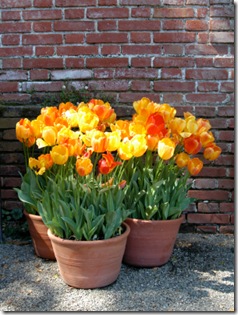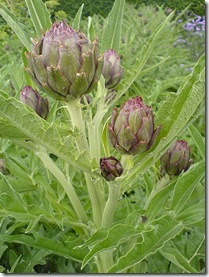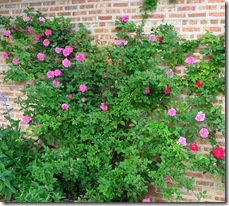If you’ve been finding the time to work in your garden in the last couple months, you probably have most of your fall trimming done – deadheading Lavender, Scotch and Irish Heather/ Heath, and Hydrangeas; and cutting back your Sedum ‘Autumn Joy’, Astilbes, Hostas, and other hardy perennials which lose their leaves.
You may have also finished raking up your leaf litter (it’s important to rake up large leaves like Maple and Sycamore, since the big leaves trap water and can cause perennials to rot. Just compost them and use the compost in spring as a great amendment or topdressing!), and if you are a super-duper A+ gardener, you’ve even applied some mulch or compost as a topdressing to help protect your soil and plants!
No worries if you haven’t done all of that yet – it’s less work than it sounds like and I find the fall maintenance tasks are my favorite to do. There’s something so satisfying about cleaning and clearing at this time of year.
But if you are finished and you are ready to think about planting some new things and getting a jump-start on your winter care, then read on…
Spring Bulbs are Going Cheap Now!
 Even if you’ve already planted your spring bulbs, you might go back to the nursery now and see what’s left! My local nurseries usually start the 50% off discounts about now, and I find that there’s usually quite a bit of good stuff left.
Even if you’ve already planted your spring bulbs, you might go back to the nursery now and see what’s left! My local nurseries usually start the 50% off discounts about now, and I find that there’s usually quite a bit of good stuff left.
If you have a lot of people to buy Christmas gifts for, why not snatch up some awesome bulbs and plant them in inexpensive terra-cotta pots with a ribbon around them? I like to choose one type of bulb per pot.
For a pot 8” or smaller, I’d cluster either Iris reticulata (mini iris), Crocus, Grape Hyacinth, regular Hyacinth, or mini Daffodils, planning so that the height of the flower is in balance with the pot’s size. You could also do species/ crocus Tulips, which stay fairly low. Bigger pots could use normal Daffs, Tulips, or Freesias.
Just ignore the instructions for how far apart to plant, and snuggle the bulbs in twice as close as the package says so you get a full look.
Dormant Spraying of Deciduous Fruit Trees
December through February is the time to get your dormant oil and lime-sulfur spray on your trees. If you don’t want to spray all through the year, this preventive spray makes a world of difference! The combination takes care of overwintering insects and fungus, and it is considered organic, though the oil is petroleum-based.
You’ll need to spray twice; once after the leaves fall, and once again in mid-January before the buds swell. Try to choose a dry, warm-ish day to spray, to give the oil a better chance of spreading out into the crevices of the bark.
When you spray, be sure and wear protective gear (I like to wear protective glasses, a hooded sweatshirt, and a scarf around my mouth and nose), and plan your spraying so that you move from one side of the plant to the other so you don’t end up getting dripped on while finishing up.
The idea is to coat every surface of the tree, top and bottom, to smother disease and insect eggs, so be as thorough as possible, and if you have bare ground or mulch underneath, rake up the remaining leaf litter before spraying and then spray the ground around the tree. Try not to hit any delicate annuals or evergreen plants with the spray – but I’ve found lawn and most sturdy shrubs aren’t harmed by inadvertent drips.
Bare-root Artichokes, Asparagus, Raspberries, and Blackberries
This is really the only time of year to get Raspberries, Blackberries, and Asparagus!
Most of the blackberries sold bare-root are non-spreading varieties, and there are even some thornless ones if, like me, you’re debating the excitement of blackberries over the grump of having scratched arms and punctures on your fingers. Plant Blackberries next to a trellis of some kind so they can climb in an orderly way.
 Raspberries and Asparagus both want to travel, so I prefer to keep them in raised planters. I have one client who has had great luck with a patch of Asparagus in an oak barrel, getting a fantastic crop yearly for the cost of a little water and organic fertilizer.
Raspberries and Asparagus both want to travel, so I prefer to keep them in raised planters. I have one client who has had great luck with a patch of Asparagus in an oak barrel, getting a fantastic crop yearly for the cost of a little water and organic fertilizer.
You can get Artichokes any time of year that you like, but they are cheap now and when buying them bare-root, you get to select the ones with the sturdiest roots!
Bare-root Roses
 The Bareroot Roses are arriving in the nurseries now, so go check out the selection! I’ve found a marked difference in how well bareroot roses do over roses purchased in late spring or summer – the time they have over the winter to grow roots makes them simply explode into growth in spring! By the end of the first year, they almost look full-grown – just a bit skinny.
The Bareroot Roses are arriving in the nurseries now, so go check out the selection! I’ve found a marked difference in how well bareroot roses do over roses purchased in late spring or summer – the time they have over the winter to grow roots makes them simply explode into growth in spring! By the end of the first year, they almost look full-grown – just a bit skinny.
I hope these new plants coming into the nursery get you excited about going outside, even though it’s getting chillier. Even with the cold temps, working outside is a great way to pump up your energy and refresh your soul. Besides, if you’re anything like me, you’ll need to work off all the Christmas cookies you’ll be eating this month!
11 responses to “December Maintenance Tasks for the Pacific Northwest”
Hi Genevieve, thanks for all these good tips on getting ready for winter. I am considering fruit trees but know they need some spraying, thanks for being so instructive about that. The bulbs are a great idea too. We have left all spent stalks standing this year as an experiment in winter design interest, no clean up, no mulch, yet. The birds are enjoying having so many places to perch and seed heads to eat too. The whole thing will be cleaned up late January for our zone 7 SE TN garden.
Frances
Frances’s last blog post..Lambs Ear Love
That sounds wonderful, Frances! There is something rather beautiful and poetic about leaving the spent stalks, with the fallen leaves laying in drifts where they fall… I have one client, a poet, naturally enough, who enjoys the cycle of life and decay each year and instructs me not to clear anything until spring.
I like the idea that the birds have more to eat that way…
Getting ready for winter is on a slightly different schedule here in New England. The nurseries are mostly selling cut greens – but I did like the idea about giving gift bulbs.
commonweeder’s last blog post..Happy Anniversary to Me!
Yeah, I’ve heard rumors of frozen ground and frost heave and all kinds of good stuff. I’ve always been a Northern Cali coastal girl, so that frosty stuff’s an education to me! I’ve gotten spoiled with our mild winters.
Gen — I know I’m a bit south of you, but you mentioned a few bare root berries, would now be a good time to find blue berries? Also, I read that they need to be planted in pairs for the best production, is that true?
Fern’s last blog post..Rain, Rain Go Away, Come Again Some Other Day: Protecting Your Balcony Garden During a Rain Storm
Hi Fern,
This is an excellent time to get the best selection of blueberries, though you can probably find some available all year round since they do come in containers and not bare-root.
At least one variety is self-fruitful and can be a loner – Sunshine Blue. It’s also a Southern Highbush variety, which means it should do well even with your mild winters, and it stays compact, to 3′, so would probably be fine in a pot.
Most blueberries do need a pollinator – a second plant of a different variety that blooms at the same time as the first plant. It makes planning your blueberry patch a tiny bit tricky, because you want the berries spread over a long season, but the blooms need to happen at the same time for the pollination to happen.
I’ve had good luck with doing three in a garden – one early midseason, one midseason, and one late midseason. They overlap in their bloom times and then make the berry season last longer than if you just had three midseason-blooming/bearing varieties.
If you just want one, I’d try out Sunshine Blue if you can find it! If you wanted two, I’d choose Tophat (1.5′ tall) as the second one – it would be pollinated by Sunshine Blue.
Thanks Gen! I think I will try to find Sunshine Blue. I have a limited amount of space and if I can get away with just one plant, that would be better for me.
Fern’s last blog post..Weekend To Do List: Take a Photo of your Favorite Indoor Plant
Hello from Norway. I realy enjoyed visiting your fantastic blog.
Signe’s last blog post..Imponerende bilder
Thanks Signe, and welcome from Norway! I love the photos you’ve used on your blog…
Hello Genevieve;
Your post about using dormant oil spray in the fall is an opportunity to tell you about its use combating the lily leaf beetle that goes after lilium. Here in Vermont I start with the first spraying when the lilies are just breaking ground and then I spray again when the stems are up about 6-8″. It’s important to spray from the ground up so you can insure that the oil gets on the under sides of the leaves. That’s where the beetles lay their eggs. If you can break the cycle early on, you can be more successful and have better looking lilies the balance of the summer. To my knowledge, this pest hasn’t made its way west to where you are yet although it is to the Rockies. The oil is probably good for other insect problems and I have been told it works to combat powdery mildew in phlox–haven’t tried that extensively yet.
Good gardening wishes!
George Africa
The Vermont Gardener
http://thevermontgardener.blogspot.com
George Africa’s last blog post..Temporary Turkey Talk
Wonderful info, thank you George! What a fantastic contribution.